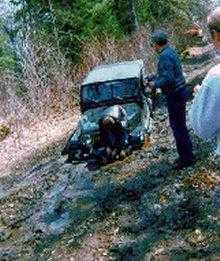
Probably one of the most important aspects pertaining to mud, is the choice of tyres fitted to the vehicle.
A tyre with a tread pattern that contains large lugs, will easily clean itself. On the other hand, some off-road tyres have small lugs, closely together which is more suitable for on-road conditions as this minimizes road noise.
Check with your local tyre fitment centre if you are unsure about the properties of your tyres. Remember, good mud tyres will actually handle badly in sand, as the wide lugs will make the tyres dig into the sand.
As with water crossings, try to walk the obstacle, looking for hidden rocks and potholes, before entering a muddy section of a trail.
Ensure that you have selected the right gear. Normally Third Gear Low range should suffice, although very thick unyielding mud could require Second Gear Low range.
In all events, ensure that your vehicle? diffs are locked before proceeding. If there is a vehicle in front of you, allow it to clear the mud obstacle completely, before attempting it yourself.
Do not even consider towing a trailer through a difficult mud obstacle!
Decide what kind of mud you are attempting to cross - there are basically two kinds.
In this case, do not deflate your vehicle's tyres at all. Doing this could make you lose control of the vehicle, as the tyres will tend to float and slide over the surface of the mud.
A correctly inflated tyre could also "break" through the muddy upper crust and provide you with firmer traction underneath in some cases.
In this case, reducing the tyre pressure can actually assist the tyres by providing additional flotation properties.
Remember to switch on your wiper blades! As more and more mud collects on your windscreen and hardens, the wiper blades may not be able to cope with the additional load later, when required.
If there has been a vehicle in front of you, follow exactly the same tracks and do not alter speed suddenly or swerve violently.
If the vehicle starts wheel spinning and slowing down, ease off the accelerator and slowly turn the steering wheel from side to side as you gently re-apply power.
Wheel spinning can clean tyres
This side-to-side turning enables the front wheels to generate extra friction that can assist in pulling the vehicle forward.
Wheel spinning as a rule of thumb is a definite no-no in 4x4ing, but in the case of mud driving, can serve a useful purpose by cleaning the treads of the tyres and thus enabling them to continue gripping the mud.
Should your vehicle become stuck, first try to reverse in the same direction as you entered.
Should this fail to free the vehicle, gently rock the vehicle forward and backward by selecting the appropriate gears.
In a worst case scenario, alternative recovery techniques need to be considered. T
he easiest way out is by using your high-lift jack and a spade.
Concentrate on the wheels that are stuck first and place suitable material underneath to provide traction, e.g. rocks, stones or even branches.
If another vehicle is available, try winching your vehicle out in the same direction as it entered the obstacle. Alternatively, should none of the vehicles be equipped with a wince, use a kinetic strap or "tuggem".
Something to consider before entering a muddy obstacle by yourself is whether you would need to winch yourself backwards, should you become stuck.
If this could be the case, run your winch cable underneath your vehicle and attach it to the back bumper or tow bar.
Should you become stuck, you would not have to lie down in the mud, trying to access your winch cable!
After successfully clearing the mud obstacle, there are a number of maintenance issues to consider, as mud tends to hold moisture against the metal parts of the vehicle, which may lead to rust & corrosion.
It is better to avoid a mud obstacle altogether, but when attempting to do so put the environment first before making unnecessary tracks!




 Publications
Publications
 Partners
Partners










